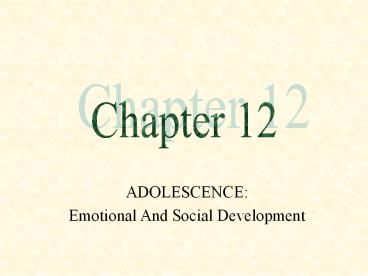ADOLESCENCE: - PowerPoint PPT Presentation
Title:
ADOLESCENCE:
Description:
Hall's Portrayal of 'Storm and Stress' Characterized by inevitable turmoil, ... Preadolescence: need for intimate relationship with same-sex playmate ... – PowerPoint PPT presentation
Number of Views:253
Avg rating:3.0/5.0
Title: ADOLESCENCE:
1
Chapter 12
- ADOLESCENCE
- Emotional And Social Development
2
Development of Identity
3
Hall
- Halls Portrayal of Storm and Stress
- Characterized by inevitable turmoil,
maladjustment, tension, rebellion, dependency
conflicts, and exaggerated peer-group conformity
4
Sullivan
- Interpersonal Theory of Development
- Preadolescence need for intimate relationship
with same-sex playmate - Early Adolescence need for sexual satisfaction,
personal intimacy and personal security - Late Adolescence satisfying sexual needs and a
sexually and personally intimate relationship
5
Erikson
- The Crisis of Adolescence
- Consists of the search for identity.
- Identity diffusion lack of ability to commit
oneself to occupation or station in life - Negative identity debased self-image and social
role - Deviant identity Lifestyle at odds with the
values and expectations of society
6
(No Transcript)
7
Marcia
- Four types of identity formation
- 1. Identity diffusion
- 2. Identity foreclosure
- 3. Identity moratorium
- 4. Identity achievement
8
(No Transcript)
9
Cultural Aspects
- Puberty Rites Initiation ceremonies that
socially symbolize the transition from childhood
to adulthood. - Less obvious in Western countries
- Adolescence Not Necessarily Stormy or
Stressful? - Bandura Only for 10 of adolescents
10
Carol Gilligan
- Adolescent Girls and Self-Esteem
- Womens model of self collectivist, ensembled
or connected - Mens model of self individualist, independent
or autonomous - Girls begin to doubt the authority of their own
inner voices.
11
(No Transcript)
12
Mary Pipher
- Identity Formation in Adolescent Girls
- Culture is destroying the identity and self
esteem of many adolescent girls.
13
Michael Gurian
- Identity Formation in Boys
- Boys need a primary and extended family,
relationships with mentors and intense support
from school and community.
14
Peers and Family
15
Youth Culture
- The Adolescent Peer Group
- Youth culture standardized ways of thinking,
feeling and acting that are characteristic of a
large body of young people.
16
Consciousness of oneness
- Sympathetic identification in which group members
feel that their inner experiences and emotional
reactions are similar
17
Status
- Obtaining high status in todays adolescent
society - Ability to project an air of confidence in ones
essential masculinity or femininity - Ability to deliver a smooth performance in a
variety of situations and settings.
18
Adolescents and Their Families
- Influence in Different Realms of Behavior
- Parents finances, education and career plans
- Peers dress, personal adornment, dating,
drinking, music and entertainment - Shift in the Family Power Equation
- Adolescents and Their Mothers
19
(No Transcript)
20
(No Transcript)
21
Courtship, Love and Sexuality
22
Courtship, Love and Sexuality
- Three images
- 1. Public health/preventive medicine
- perspective
- 2. Conservative moral view
- 3. Conservative economic approach
23
Differing Behavioral Patterns
- Higher rates of sexual intercourse for
adolescents in single-parent families - Less parental supervision
- Single parents date sexual behavior as role
model for teens - Divorced parents more permissive attitudes
about sex
24
Courtship
- Changes in dating behaviors
25
Love
- Some societies do not believe in romantic love.
- Some psychologists romantic love a state of
physiological arousal that individuals define as
love. - Leibowitz love has a unique chemical basis.
26
Sexual Attitudes and Behavior
- Development of Sexual Behavior
- Adolescent Sexual Expression
27
Sexual Activity Rates
- Increased through the 80s, plateaued in the
early 90s, declined through 1997 - Multiple Sex Partners
- Percentage decreased overall
28
Teenage Pregnancy
- 1 of every 10 teenaged girls becomes pregnant.
- Mixed messages about contraception
- Why Do Teenagers Become Pregnant?
- Most teenagers seek contraceptive care one year
after first sexual activity.
29
Teenage Pregnancy
- The Young Teen Mother
- Sex Education, Safe Sex and Contraception
- Abortion
30
Sexual Orientation
- One in four enter adolescence unsure of their
sexual orientation. - By 18, most deem themselves heterosexual or
homosexual. - Difficult adolescence for homosexuals
31
Career Development and Vocational Choice
32
World of Work
- Preparing for the World of Work
- Adolescents ill-prepared for making vocational
decisions - Changing Employment Trends in the U.S.
- Young Americans without skills and often those
with them, cannot count on a decent job.
33
(No Transcript)
34
Balancing School and Work
- 20 or more hours a week more stress
- Dropping out of High School
- Rate between 11 to 23
35
Risky Behaviors
36
Alcohol and Drugs
- Social Drinking and Drug Abuse
- Drug abuse excessive or compulsive use of
chemical agents interferes with health, social
or vocational functioning and functioning of
society.
37
Binge Drinking
- Downing five or more drinks in a row for men
- Four or more for women
38
Why do Teens Use Drugs?
- Recreational use central to many adolescent peer
groups - Teenage Suicide
- Third leading cause of death among adolescents
39
(No Transcript)
40
(No Transcript)
41
Teenage Suicide
- Risk factors
- Depression characterized by prolonged feelings
of gloom, despair, futility, profound pessimism
and tendency toward guilt and self-reproach.
42
Suicide Prevention
- Strongest risk factor firearm at home
- Treatment with psychotherapy and antidepressants
43
(No Transcript)
44
Antisocial Behaviors
- Families and neighbors hold the keys to cutting
crime. - Violence and Age
- Young people 12-17 are the most frequent victims
of violent crime in the U.S.

